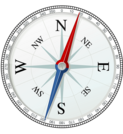
These lessons are adapted and modified for an inclusive classroom
- Material Type:
- Activity/Lab
- Author:
- gayle see
- Barbara Soots
- Date Added:
- 05/23/2023

These lessons are adapted and modified for an inclusive classroom
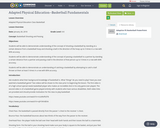
Adapted Physical Education Class BasketballLesson OverviewDate: January 28, 2018 Grade Level: 6-8Concept: Basketball Shooting and PassingObjectives:Students will be able to demonstrate understanding of the concept of shooting a basketball by standing at a certain distance from a basketball hoop and shooting a ball in the direction of the hoop up to 5 times in a row with 80% accuracy. Students will be able to demonstrate understanding of the concept of passing a basketball to a partner by standing a certain distance from a partner and passing a ball in the direction of that person up to 5 times in a row with 80% accuracy. Students will be able to demonstrate an understanding of catching a basketball by attempting to catch a ball thrown at them at least 5 times in a row with 80% accuracy. Introduction:Ask students what their background knowledge of basketball is. What “things” do you need to play? Have you ever watched a basketball game? Two videos will be shown to the class prior to beginning the lesson. The first video is of a high school special needs basketball player who makes an incredible shot in his only game ever played. The second video is of a basketball game played entirely with students who have various disabilities. Both video links are provided and should provide motivation for the class to play basketball. https://www.youtube.com/watch?v=nUztRvfhDT8https://www.youtube.com/watch?v=oJFr5KVdEXA Vocabulary:Chest Pass- the basketball is passed directly from the passer 's chest to the receiver 's chest.Bounce Pass- the basketball bounces about two-thirds of the way from the passer to the receiver.Overhead Pass- the player holds the ball over their head with both hands and then tosses the ball to a teammate.Shooting form- Put the ball in your shooting hand make sure your body is square to the basket, and put your feet shoulder width apart, and also put your elbow in towards your body. Body of Lesson:After watching the introduction videos, students will come into the gym and partner up. One ball will be given to each set of partners. Students will stand 5-10 feet away from each other depending on the level of comfort felt by students to catch a ball. The instructor will demonstrate a chest pass and then have students practice this pass several times back and forth with their partner. The instructor will come around and help any students who are in need of assistance. When students are comfortable with this type of pass they may begin to back up and get farther away from their partner. These same steps will be repeated for the bounce pass and the overhead pass. Depending on student strength, they may begin these skills with a balloon or beach ball to gain confidence and correct form before moving on to the basketball.After the instructor is able to assess each student on each type of pass, the class will move on to shooting. The instructor will demonstrate the correct shooting form and then students will be allowed to go to a basket to practice this form. One student will shoot while their partner rebounds the ball for them, after ten shots the students will switch roles. Students will be instructed to start only a few feet away from the basket until they are able to make two shots in a row, afterwards they can move back another few feet until they are unable to make a shot. The instructor will walk around the gym and make any shooting corrections that are needed and assess each student on their ability to shoot a basketball at the hoop. Depending on disability, students may feel more comfortable and confident using a hula hoop for the basketball hoop and/or garbage can as a larger surface.Multiple Intelligences:Students will use the following multiple intelligences through participation in Adaptive PE:•Kinesthetic-Students who enjoy being on the go as much as possible. Learn best by doing—hands-on activities and incorporate body movement. Examples in PE class would be walking, passing and shooting the basketball.•Interpersonal-Those students who show good social skills and partake in group or team activities. Examples in PE class would be partnering up to pass the ball back and forth, participating in a mock basketball game.•Musical-Rhythmic-Students connect to an activity through familiar tunes of music. Examples in PE—having a song to keep rhythm of passing the ball back and forth. Accommodations/Modifications: Multiple accommodations are made depending on the abilities of the students in the class. These are as follows:Deaf/Hearing Impairment 1. Brighter ball helps to make up for a player calling your name to pass you the ball. 2. Lights to signal a whistle. 3. Make hand signaled plays not verbal. 4. Give a written outline of the day’s events. Cognitive Impairments 1. Repeat instructions clearly and slowly. 2. Quick/simple instructions. 3. Use larger materials (beach balls and hula hoops) 4. Give motivation for small goals (catch a ball) then work higher (make a basket). 5. Enhance success rate by awarding points for passes and catches. 6. Many rules can be changed (allow double dribbling, no time limit in the lane, etc.). Visual Impairment 1. Orient player on the court and give an area to cover. 2. Brighter colored equipment. 3. Brighter boundary lines. 4. Beeper in the ball. 5. Lighted hoops. 6. In drills, use a ball retrieving device or set up in partners. 7. Catch the ball with arms extended to feel the ball and bring into the body. 8. Call the person’s name before passing to them. 9. Bounce passes are easier to track and slower pace. 10. Place a beeper behind the goal to help in aiming at the target. Orthopedic Impairment 1. Use the two-hand chest pass. 2. When shooting, do not go head on; easier to go slightly to the non-dominant side. 3. Adaptations to the game a. Travel if more than two pushes are taken with ball in lap. b. Can only dribble twice then must pass, shoot, or take two additional pushes. c. Remain seated at all times. d. Place all players in wheelchairs. One Arm Involvement 1. Trap the ball with the body to catch the ball. 2. Throw with one arm. 3. Overhead passes for long throws. 4. Stop dribble then place ball on the hand for a shot. One Leg Involvement 1. Bring the ball to the side of the body instead of towards the body to catch the ball. 2. Students who use crutches can use the one arm throw. 3. Students who use crutches are successful with the one arm shot. 4. One regular crutch and one Lofstrand crutch helps to free one arm quickly(Adaptation and modification information was compiled by Jenny Walter, Adapted Physical Education student at Manchester College, Spring 2008).Assessment: Formative assessment: Observation will be used throughout the lesson to correct student form and give feedback. Students who are completing the passes and shooting correctly will be allowed to move farther distances away from their target to increase difficulty for those who are capable of performing the skills. Summative assessment: The instructor will have a checklist for each student to determine if they met the objectives for the day. The checklist is attached. Materials: Computer, projector, internet access, several basketballs (beach balls, balloons, lighter basketballs), basketball hoops (hula hoops, garbage cans), beeper balls, beeper cones, whistles, specialized equipment lights, specialized brightly colored balls, boundaries, targets, etc. Standard(s): A physically educated individual:· Demonstrates competency in motor skills and movement patterns needed to perform a variety of physical activities.· Demonstrates understanding of movement concepts, principles, strategies, and tactics as they apply to the learning and performance of physical activities.· Participates regularly in physical activity.· Exhibits responsible personal and social behavior that respects self and others in physical activity settings.· Values physical activity for health enjoyment challenge, self-expression and/or social interaction.· PE 8.1.2 Students demonstrate critical elements of specialized manipulative skills in modified team activities.· PE 8.2.4 Students engage in a variety of physical activities that will enhance health-related fitness (inside and/or outside of school).
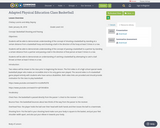
Chelsey Loomis and Abby DepreyDate: January 28, 2018 Grade Level: 6-8Concept: Basketball Shooting and PassingObjectives:Students will be able to demonstrate understanding of the concept of shooting a basketball by standing at a certain distance from a basketball hoop and shooting a ball in the direction of the hoop at least 5 times in a row. Students will be able to demonstrate understanding of the concept of passing a basketball to a partner by standing a certain distance from a partner and passing a ball in the direction of that person at least 5 times in a row. Students will be able to demonstrate an understanding of catching a basketball by attempting to catch a ball thrown at them at least 5 times in a row. Introduction:Two videos will be shown to the class prior to beginning the lesson. The first video is of a high school special needs basketball player who makes an incredible shot in his only game ever played. The second video is of a basketball game played entirely with students who have various disabilities. Both video links are provided and should provide motivation for the class to play basketball. https://www.youtube.com/watch?v=nUztRvfhDT8https://www.youtube.com/watch?v=oJFr5KVdEXA Vocabulary:Chest Pass- the basketball is passed directly from the passer 's chest to the receiver 's chest.Bounce Pass- the basketball bounces about two-thirds of the way from the passer to the receiver.Overhead Pass- the player holds the ball over their head with both hands and then tosses the ball to a teammate.Shooting form- Put the ball in your shooting hand make sure your body is square to the basket, and put your feet shoulder width apart, and also put your elbow in towards your body. Body of Lesson:After watching the introduction videos, students will come into the gym and partner up. One ball will be given to each set of partners. Students will stand 5-10 feet away from each other depending on the level of comfort felt by students to catch a ball. The instructor will demonstrate a chest pass and then have students practice this pass several times back and forth with their partner. The instructor will come around and help any students who are in need of assistance. When students are comfortable with this type of pass they may begin to back up and get farther away from their partner. These same steps will be repeated for the bounce pass and the overhead pass. Depending on student strength, they may begin these skills with a balloon or beach ball to gain confidence and correct form before moving on to the basketball.After the instructor is able to assess each student on each type of pass, the class will move on to shooting. The instructor will demonstrate the correct shooting form and then students will be allowed to go to a basket to practice this form. One student will shoot while their partner rebounds the ball for them, after ten shots the students will switch roles. Students will be instructed to start only a few feet away from the basket until they are able to make two shots in a row, afterwards they can move back another few feet until they are unable to make a shot. The instructor will walk around the gym and make any shooting corrections that are needed and assess each student on their ability to shoot a basketball at the hoop. Depending on disability, students may feel more comfortable and confident using a hula hoop for the basketball hoop and/or garbage can as a larger surface.Multiple Intelligences:Students will use the following multiple intelligences through participation in Adaptive PE:•Kinesthetic-Students who enjoy being on the go as much as possible. Learn best by doing—hands-on activities and incorporate body movement•Interpersonal-Those students who show good social skills and partake in group or team activities•Musical-Rhythmic-Students connect to an activity through familiar tunes of music. Accommodations/Modifications: Multiple accommodations are made depending on the abilities of the students in the class. These are as follows:Deaf/Hearing Impairment 1. Brighter ball helps to make up for a player calling your name to pass you the ball. 2. Lights to signal a whistle. 3. Make hand signaled plays not verbal. 4. Give a written outline of the day’s events. Cognitive Impairments 1. Repeat instructions clearly and slowly. 2. Quick/simple instructions. 3. Use larger materials (beach balls and hula hoops) 4. Give motivation for small goals (catch a ball) then work higher (make a basket). 5. Enhance success rate by awarding points for passes and catches. 6. Many rules can be changed (allow double dribbling, no time limit in the lane, etc.). Visual Impairment 1. Orient player on the court and give an area to cover. 2. Brighter colored equipment. 3. Brighter boundary lines. 4. Beeper in the ball. 5. Lighted hoops. 6. In drills, use a ball retrieving device or set up in partners. 7. Catch the ball with arms extended to feel the ball and bring into the body. 8. Call the person’s name before passing to them. 9. Bounce passes are easier to track and slower pace. 10. Place a beeper behind the goal to help in aiming at the target. Orthopedic Impairment 1. Use the two-hand chest pass. 2. When shooting, do not go head on; easier to go slightly to the non-dominant side. 3. Adaptations to the game a. Travel if more than two pushes are taken with ball in lap. b. Can only dribble twice then must pass, shoot, or take two additional pushes. c. Remain seated at all times. d. Place all players in wheelchairs. One Arm Involvement 1. Trap the ball with the body to catch the ball. 2. Throw with one arm. 3. Overhead passes for long throws. 4. Stop dribble then place ball on the hand for a shot. One Leg Involvement 1. Bring the ball to the side of the body instead of towards the body to catch the ball. 2. Students who use crutches can use the one arm throw. 3. Students who use crutches are successful with the one arm shot. 4. One regular crutch and one Lofstrand crutch helps to free one arm quickly(Adaptation and modification information was compiled by Jenny Walter, Adapted Physical Education student at Manchester College, Spring 2008).Assessment: Formative assessment: Observation will be used throughout the lesson to correct student form and give feedback. Students who are completing the passes and shooting correctly will be allowed to move farther distances away from their target to increase difficulty for those who are capable of performing the skills. Summative assessment: The instructor will have a checklist for each student to determine if they met the objectives for the day. The checklist is attached. Materials: Computer, projector, internet access, several basketballs (beach balls, balloons, lighter basketballs), basketball hoops (hula hoops, garbage cans), beeper balls, beeper cones, whistles, specialized equipment lights, specialized brightly colored balls, boundaries, targets, etc. Standard(s): A physically educated individual:· Demonstrates competency in motor skills and movement patterns needed to perform a variety of physical activities.· Demonstrates understanding of movement concepts, principles, strategies, and tactics as they apply to the learning and performance of physical activities.· Participates regularly in physical activity.· Exhibits responsible personal and social behavior that respects self and others in physical activity settings.· Values physical activity for health enjoyment challenge, self-expression and/or social interaction.· PE 8.1.2 Students demonstrate critical elements of specialized manipulative skills in modified team activities.· PE 8.2.4 Students engage in a variety of physical activities that will enhance health-related fitness (inside and/or outside of school).

These lessons show adaptations and modifications.

An introduction to the chapter "Adapting and Living Together" within the Ecology and Environment topic of the virtual school GCSE Biology.

This template supports faculty and staff as they interrogate their OER and iterate the resource. This template is part of a Canvas course titled Adapting OER to Incorporate UDL. The initial course is offered by ISKME to California Community College faculty and staff and was created with support from the Michelson Foundatin's Spark Grant Program.

This template supports faculty and staff as they interrogate their OER and iterate the resource. This template is part of a Canvas course titled Adapting OER to Incorporate UDL. The initial course is offered by ISKME to California Community College faculty and staff and was created with support from the Michelson Foundatin's Spark Grant Program.

This template supports faculty and staff as they interrogate their OER and iterate the resource. This template is part of a Canvas course titled Adapting OER to Incorporate UDL. The initial course is offered by ISKME to California Community College faculty and staff and was created with support from the Michelson Foundatin's Spark Grant Program.
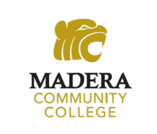
This template supports faculty and staff as they interrogate their OER and iterate the resource. This template is part of a Canvas course titled Adapting OER to Incorporate UDL. The initial course is offered by ISKME to California Community College faculty and staff and was created with support from the Michelson Foundatin's Spark Grant Program.

This template supports faculty and staff as they interrogate their OER and iterate the resource. This template is part of a Canvas course titled Adapting OER to Incorporate UDL. The initial course is offered by ISKME to California Community College faculty and staff and was created with support from the Michelson Foundatin's Spark Grant Program.

This template supports faculty and staff as they interrogate their OER and iterate the resource. This template is part of a Canvas course titled Adapting OER to Incorporate UDL. The initial course is offered by ISKME to California Community College faculty and staff and was created with support from the Michelson Foundatin's Spark Grant Program.

The Mt. San Antonio College team completed this as part of a Canvas course titled Adapting OER to Incorporate UDL. The initial course was offered by ISKME to California Community College faculty and staff and was created with support from the Michelson Foundation's Spark Grant Program.
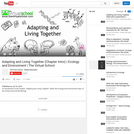
An introduction to the chapter "Adapting and Living Together" within the Ecology and Environment topic of the virtual school GCSE Biology.
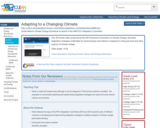
This 20-minute video, produced by the UN Framework Convention on Climate Change, describes adaptation strategies undertaken by several groups and nations in response to rising sea level and other aspects of climate change.
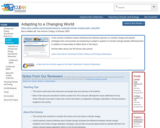
In this activity, students assess individual and national opinions on climate change and explore strategies that communities are employing to adapt to aspects of climate change already affecting them in addition to those likely to affect them in the future.
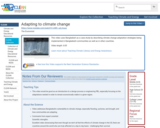
This video uses Bangladesh as a case study by describing climate change adaptation strategies being implemented in Bangladeshi communities as well as in other countries.

The 16 lectures in this course cover the topics of adaptive antennas and phased arrays. Both theory and experiments are covered in the lectures. Part one (lectures 1 to 7) covers adaptive antennas. Part two (lectures 8 to 16) covers phased arrays. Parts one and two can be studied independently (in either order). The intended audience for this course is primarily practicing engineers and students in electrical engineering. This course is presented by Dr. Alan J. Fenn, senior staff member at MIT Lincoln Laboratory.
Online Publication
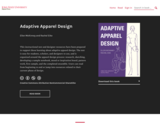
This instructional text and designer resources have been prepared to support those learning about adaptive apparel design. The text is easy for students, scholars, and designers to use, and is organized around the apparel design process: research, sketching, developing a sample notebook, mood or inspiration board, pattern work, first sample, and the completed ensemble. Users can read from beginning to end or jump into resources related to their current phase of design.
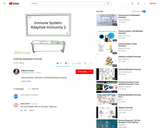
Short video on adaptive immunity for anatomy and physiology.

Economists can’t agree on whether investors and markets are rational and efficient, as modern financial theory assumes, or irrational and inefficient, as behavioral economists believe. Drawing on psychology, evolutionary biology, neuroscience, artificial intelligence, and other fields, Prof. Lo cuts through the debate in this course with a new framework—the Adaptive Markets Hypothesis—in which rationality and irrationality coexist.
Topics:
Introduction and Financial Orthodoxy
Rejecting the Random Walk and Efficient Markets
Behavioral Biases and Psychology
The Neuroscience of Decision-Making
Evolution and the Origin of Behavior
The Adaptive Markets Hypothesis
Hedge Funds: The Galapagos Islands of Finance
Applications of Adaptive Markets
The Financial Crisis
Ethics and Adaptive Markets
The Finance of the Future and the Future of Finance
As part of the Open Learning Library (OLL), this course is free to use. You have the option to sign up and enroll if you want to track your progress, or you can view and use all the materials without enrolling. Resources on OLL allow learners to learn at their own pace while receiving immediate feedback through interactive content and exercises.